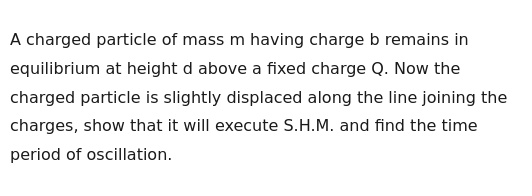Question
Question: A charged particle of mass m having charge b remains in equilibrium at height d above a fixed charge...
A charged particle of mass m having charge b remains in equilibrium at height d above a fixed charge Q. Now the charged particle is slightly displaced along the line joining the charges, show that it will execute S.H.M. and find the time period of oscillation.

T = 2\pi \sqrt{\frac{2\pi\epsilon_0 m d^3}{Q b}}
Solution
The problem describes a charged particle of mass m and charge b in equilibrium at a height d above a fixed charge Q. This equilibrium is maintained by the balance between the electrostatic force and the gravitational force.
1. Equilibrium Condition:
For the particle to be in equilibrium at height d, the upward electrostatic force must balance the downward gravitational force.
The electrostatic force F_e = \frac{1}{4\pi\epsilon_0} \frac{Q b}{d^2}.
The gravitational force F_g = mg.
For equilibrium:
F_e = F_g
\frac{1}{4\pi\epsilon_0} \frac{Q b}{d^2} = mg \quad \text{(Equation 1)}
Note: For the electrostatic force to be repulsive (upwards), Q and b must have the same sign.
2. Displacement and Net Force:
Now, the particle is slightly displaced along the line joining the charges. This means it is displaced vertically. Let the particle be displaced upwards by a small distance x from its equilibrium position. Its new height above Q will be (d+x).
The new electrostatic force F_e'(x) at height (d+x) is:
F_e'(x) = \frac{1}{4\pi\epsilon_0} \frac{Q b}{(d+x)^2}
The gravitational force F_g = mg remains constant.
The net force F_net(x) acting on the particle (taking upward as positive) is:
F_net(x) = F_e'(x) - F_g
F_net(x) = \frac{1}{4\pi\epsilon_0} \frac{Q b}{(d+x)^2} - mg
Substitute mg from Equation 1:
F_net(x) = \frac{1}{4\pi\epsilon_0} \frac{Q b}{(d+x)^2} - \frac{1}{4\pi\epsilon_0} \frac{Q b}{d^2}
F_net(x) = \frac{Q b}{4\pi\epsilon_0} \left[ \frac{1}{(d+x)^2} - \frac{1}{d^2} \right]
F_net(x) = \frac{Q b}{4\pi\epsilon_0} \left[ \frac{d^2 - (d+x)^2}{d^2 (d+x)^2} \right]
F_net(x) = \frac{Q b}{4\pi\epsilon_0} \left[ \frac{d^2 - (d^2 + 2dx + x^2)}{d^2 (d+x)^2} \right]
F_net(x) = \frac{Q b}{4\pi\epsilon_0} \left[ \frac{-2dx - x^2}{d^2 (d+x)^2} \right]
3. Small Displacement Approximation (x << d):
Since x is a small displacement, we can make the following approximations:
- In the numerator,
x^2is much smaller than2dx, so(-2dx - x^2) \approx -2dx. - In the denominator,
(d+x)^2 \approx d^2. So,d^2 (d+x)^2 \approx d^2 \cdot d^2 = d^4.
Applying these approximations to F_net(x):
F_net(x) \approx \frac{Q b}{4\pi\epsilon_0} \left[ \frac{-2dx}{d^4} \right]
F_net(x) \approx - \left( \frac{2 Q b}{4\pi\epsilon_0 d^3} \right) x
4. Simple Harmonic Motion (SHM):
The net force is in the form F_net(x) = -K_{eff} x, where K_{eff} = \frac{2 Q b}{4\pi\epsilon_0 d^3}.
This form of force (restoring force proportional to displacement and opposite in direction) indicates that the particle will execute Simple Harmonic Motion (SHM).
5. Time Period of Oscillation:
For SHM, the angular frequency \omega is given by \omega = \sqrt{\frac{K_{eff}}{m}}.
\omega = \sqrt{\frac{2 Q b / (4\pi\epsilon_0 d^3)}{m}}
\omega = \sqrt{\frac{2 Q b}{4\pi\epsilon_0 m d^3}}
The time period T is given by T = \frac{2\pi}{\omega}.
T = 2\pi \sqrt{\frac{4\pi\epsilon_0 m d^3}{2 Q b}}
T = 2\pi \sqrt{\frac{2\pi\epsilon_0 m d^3}{Q b}}
The motion will be simple harmonic, and its time period is T = 2\pi \sqrt{\frac{2\pi\epsilon_0 m d^3}{Q b}}.
